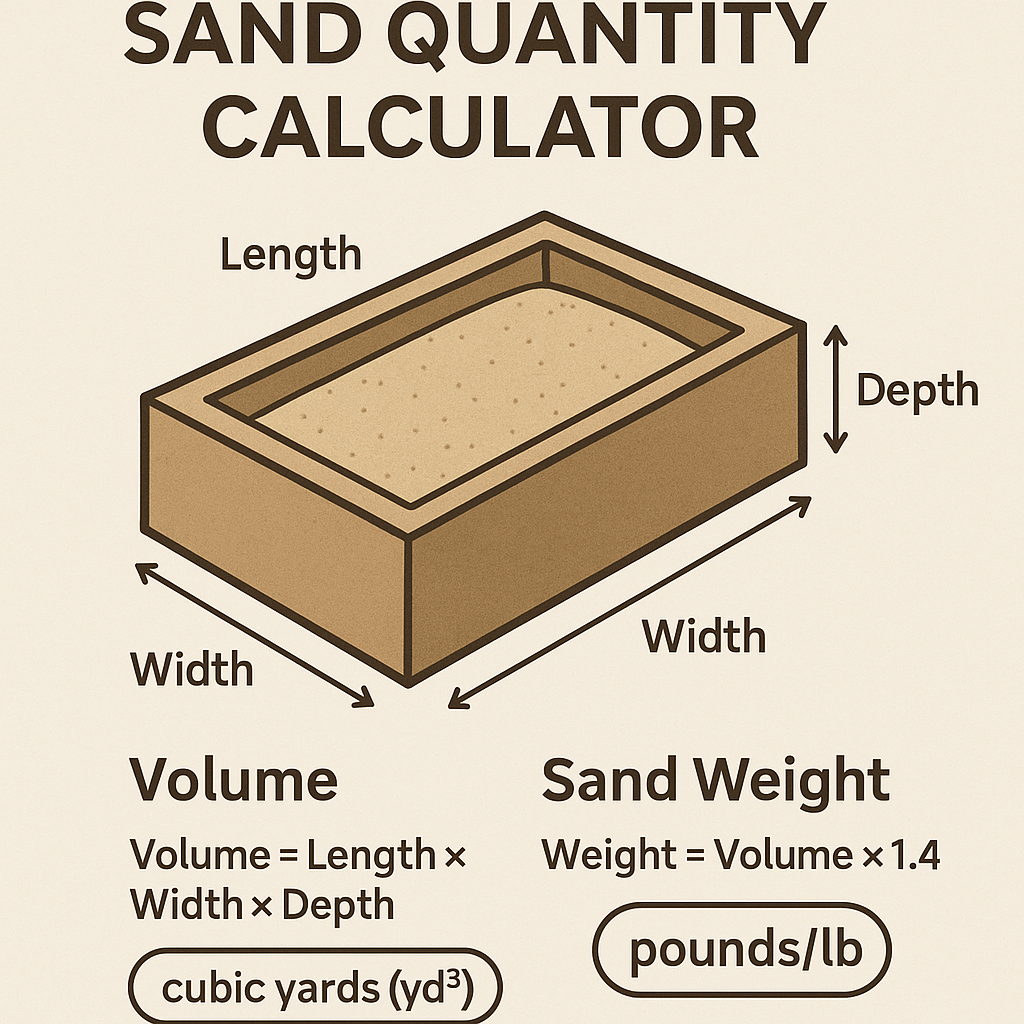Free Sand Quantity Calculator Online
Sand is a fundamental component in construction, whether you’re mixing concrete, preparing a mortar bed, filling trenches, or laying a paver base. Calculating the right amount of sand is essential to avoid waste, save costs, and keep your project running smoothly. The Construction Calculators platform offers a Sand Quantity Calculator that helps you quickly determine how much sand is needed based on your project’s dimensions, coverage depth, and specific application—ensuring precision and efficiency from start to finish.
This guide explains how to use the calculator, includes formulas for conversions, and provides real-world examples and recommendations for accurate planning.
What Is a Sand Quantity Calculator?
A Sand Quantity Calculator is a tool used to estimate the volume or weight of sand needed for a specific construction area. You input the length, width, and desired depth, and the calculator provides output in:
- Cubic feet
- Cubic yards
- Tons or kilograms
- Number of sandbags (optional)
It helps contractors, landscapers, and DIY builders prepare for tasks like laying pavers, pouring concrete, or backfilling trenches.

Why Accurately Estimating Sand Matters
Underestimating sand can lead to delays and uneven surfaces, while overestimating results in wasted material, storage issues, and increased costs. Accurate sand calculations:
- Save money on overordering
- Ensure you have enough material to complete the job
- Help you match supplier pricing based on volume or weight
- Reduce the environmental impact by minimizing waste
How to Use the Sand Quantity Calculator
To use the calculator, enter the following:
- Length of area (feet or meters)
- Width of area (feet or meters)
- Depth of sand layer (inches, feet, or cm)
Volume Formula (Imperial Units)
$$[
\text{Volume (cubic feet)} = \text{Length (ft)} \times \text{Width (ft)} \times \text{Depth (ft)}
]$$
To convert to cubic yards: $$[
\text{Volume (cubic yards)} = \frac{\text{Cubic feet}}{27}
]$$
To convert to tons (based on average density): $$\text{Tons} = \text{Cubic yards} \times 1.35$$
(1 cubic yard of dry sand weighs approximately 2,700 lbs or 1.35 tons.)
Step-by-Step Example
Project: Paver base preparation
- Length = 20 ft
- Width = 12 ft
- Depth = 4 inches = 0.33 ft
Step 1: Calculate Volume in Cubic Feet
$$20 \times 12 \times 0.33 = 79.2 \text{ cu ft}$$
Step 2: Convert to Cubic Yards
$$[
\frac{79.2}{27} = 2.93 \, \text{cu yd}
]$$
Step 3: Convert to Tons
$$2.93 \times 1.35 = 3.96 \, \text{tons}$$
You’ll need approximately 4 tons of sand for the project.
Common Applications and Recommended Depths
| Use Case | Depth |
|---|---|
| Paver base | 4–6 inches |
| Leveling layer (screed) | 1–2 inches |
| Mortar mix | Per mix ratio |
| Playground base | 6–12 inches |
| Backfilling trenches | Varies |
Sand Weight and Density Reference
| Sand Type | Approx. Weight (lbs/cu ft) | Approx. Tons/cu yd |
|---|---|---|
| Dry sand | 100 | 1.35 |
| Wet sand | 120 | 1.6 |
| Coarse sand | 105 | 1.42 |
| Play sand | 80–90 | 1.2–1.3 |
Always ask your supplier for exact product density, especially for bulk orders.
Sandbags for Small Projects
If you’re using 50-lb bags of sand:
- Each bag covers about 0.5 cubic feet
- $$\text{Bags} = \frac{\text{Volume (cu ft)}}{0.5}$$
Example:
79.2 cu ft ÷ 0.5 = 158 bags
Sand for Concrete Mixes
For standard concrete (1:2:3 mix), sand makes up roughly ⅓ of the total volume. If you’re pouring a slab and using a concrete calculator, divide the volume by 3 to estimate sand quantity.
Tips for Ordering and Handling Sand
- Add 5–10% extra for compaction, wastage, or uneven ground
- Check moisture wet sand weighs more and affects mix ratios
- Store sand on a tarp or in a bin to keep it dry and clean
- Compact base layers in 2-inch lifts to prevent settling
- Get quotes by ton and yard to compare prices accurately
Frequently Asked Questions
How many tons are in 1 cubic yard of sand?
On average:
- Dry sand = 1.35 tons
- Wet sand = 1.5–1.6 tons
How much sand do I need for a 100 sq ft area?
Assuming a 2-inch depth: $$100 \, \text{sq ft} \times \frac{2}{12} \, \text{ft} = 16.7 \, \text{cu ft}$$
$$16.7 ÷ 27 = 0.62 cu yd$$
$$0.62 × 1.35 = ~0.84 tons$$
How many bags of sand do I need per cubic yard?
$$1 cubic yard = 27 cu ft$$
$$50 lb bag = 0.5 cu ft$$
$$27 ÷ 0.5 = 54 bags$$
Can I use play sand as paver base?
Play sand is too fine. Use coarse or angular sand for proper drainage and compaction under pavers.
How do I calculate sand needed for a sandbox?
Just multiply the interior dimensions by desired fill depth. Then use the conversion chart to find volume or weight.
Related Calculators
- Concrete Volume Calculator – For slabs and footings
- Paver Calculator – To pair sand with surface materials
- Mortar Mix Calculator – For cement + sand mixtures
- Gravel Calculator – When layering under sand
- Rebar Calculator – For reinforced slabs using sand base
Conclusion
The Sand Quantity Calculator makes it easy to determine how much sand you need—whether for leveling pavers, mixing mortar, or building a sandbox. Input your area’s dimensions, set your depth, and get instant volume, weight, and even bag estimates. Available on the Concrete Calculators platform, this tool works alongside other practical resources like the Epoxy Calculator for coating applications and the Paver Calculator for accurate surface planning, ensuring every phase of your construction project is measured, efficient, and cost-effective.
Proper planning means fewer trips to the supplier, smoother project timelines, and better results on the job site. Use the calculator before buying, and always round up slightly to stay ahead.
